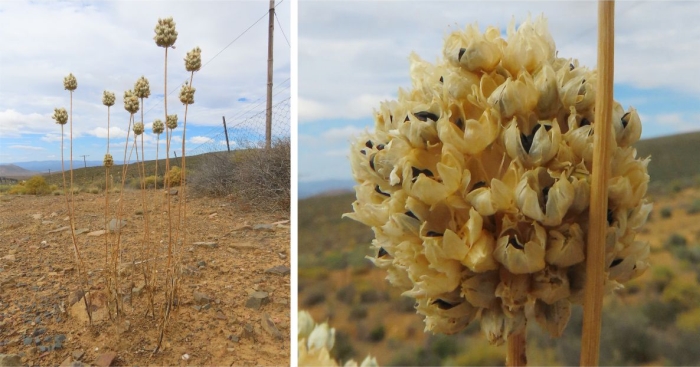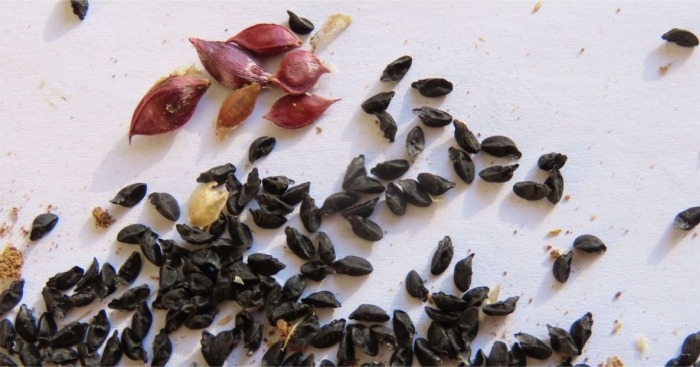Allium synnotii
Allium synnotii G.Don (= A. dregeanum Kunth)
Family: Amaryllidaceae
Common names: wild onion, Cape onion (Eng.), ajuin, wilde-ajuin, ajuintjie, berg-ajuin (Afr.)
Introduction
The wild onion (Allium synnotii) grows widespread in the drier regions of the winter-rainfall region. Plants are usually solitary, but grow in groups, with an edible, underground bulb, aromatic, green, linear leaves and a dense, spherical flowerhead of white to purplish flowers, in spring. Best grown in containers.

Fig. 1. Allium synnotii, a close-up of the umbel of a dark pink form, growing north east of Ceres, Western Cape.
Description
Description
The plants are solitary, the bulb about 30–40 mm below soil level, dormant during summer. Bulbs egg-shaped, 20–25 mm long and about 10–15 mm in diameter, producing numerous bulbils at the base, the bulbils 6–10 × 2–7 mm in diameter, with shiny purple tunics. Roots fibrous, radiating from the basal plate. The bulb tunics purplish, inner paler, membranous. The peduncle solitary, erect, terete, up to 4 mm in diameter at base, 280–490 mm long. Leaves 3 to 5, linear, 3–5 mm in diameter, ascending spreading, up to about 130 mm long, with basal amplexicaul sheath.

Fig. 2. Allium synnotii bulbs during summer; Left collected north of Matjiesfontein, Right plants from north east of Ceres.
The inflorescence 380–490 mm tall, with a globose umbel, 25–30 × 25–30 mm, the pedicels 6–10 mm long, the perianth campanulate, the tepals ovate, white tinged pink to purplish, 3-nerved, about 5–6 × 4 mm, acute at the apices. The stamens shorter than the segments. Ovary triangular ovate, with its style shorter than the ovary. Fruit a capsule, globose and green at first 5–6 mm long and about 5 mm in diameter, when open the segments 5 × 4 mm, ribbed. Seed black, wrinkled, shiny, 3–4 × 1.5 mm. Flowering time is in spring and early summer (October to December), and seed is dispersed in summer to autumn.
Conservation Status
Status
Plants are widespread and not threatened. Consequently Allium synnotii was assessed as Least Concern (LC) in the Red List of South African plants.

Fig. 3. Allium synnotii in fruit, growing north of Matjiesfontein, Western Cape, and a close-up of the dry umbel.
Distribution and habitat
Distribution description
The wild onion is widespread in the winter-rainfall region and less so in the summer-rainfall region, usually in semi-arid regions. It has been recorded in Namaqualand in the Northern Cape, from Clanwilliam to Riversdale in the Western Cape, to the Langkloof in the Eastern Cape, and has also been recorded as far north east as Carnavon in the Northern Cape, and the Caledon River in the Free State and eastwards there are records from Graaff-Reinet and as far east as the Stormsberg range near Queenstown in the Eastern Cape. They usually grow on hilly slopes, in well-drained soil, on gravely, clayey loam substrate. The author has observed plants growing on granite (Ploegberg, Richtersveld) and on shale substrate at other sites in the Western Cape.
Allium dregeanum has been recorded from about 50 m to 1 500 m above sea level. Winters are cool, with occasional frost. Rainfall in the winter-rainfall region is mainly between May and October, 150–670 mm per annum in the form of cyclonic winter rain & thunder showers.
In the winter-rainfall region of South Africa Allum synnotii has been recorded from both the Fynbos and Succulent Karoo Biomes. In the fynbos it has been recorded from Shale Renosterveld and on the Ploegberg in Succulent Karroo (Goariep Mountain Succulent Shrublands) (Mucina et al. 2006).
Derivation of name and historical aspects
History
This species was named Allium dregeanum by the Leipzig born German botanist Carl Sigismund Kunth (1788–1850) in his Enumeratio Plantarum Omnium Hucusque Cognitarum, Secundum Familias Naturales Disposita, Adjects Characteribus, Differentiis et Synonymis. Stutgardiae et Tubingae in 1843.The specific epithet honours Johann Fran(t)z Drège (1794 – 1881), a German horticulturist and botanist of Huguenot descent, who collected plants in the Stormberg mountains near Queenstown (Eastern Cape). Drège made a very large contribution to Botany, collecting many plants in South Africa. Although it is still known by this name, it is, nevertheless, an invalid name, because George Don named the same species Allium synnotii in his monograph of the genus Allium, published in the Memoirs of the Wernerian Natural History Society in 1827, and since his name is earlier, it takes precedence and is the current valid name for this species. George Don (1798–1856) was a Scottish botanist and plant collector. He named it after a Mr Synnot, who brought the plant home from the Cape of Good Hope in 1825.
The name Allium is the Latin name for garlic. All was the Celtic word for hot, pungent or burning, referring to the taste, or effect on the eyes, of these plants.
Allium synnotii belongs to the subfamily Alliaceae of the family Amaryllidaceae. The genus Allium consists of about 920 species widespread in in the Northern Hemisphere. Allium synnotii is the only species of Allium recorded for South Africa (Christenhusz et al 2017).

Fig. 4. Allium synnotii in flower, a close-up of the umbel of a light pink form, north east of Ceres, Western Cape.
Ecology
Ecology
This plant has been used as a food source by the indigenous Khoi and San people for a very long time, and is an example of a plant co-adapting to human usage. Every time a bulb is lifted from the soil, some bulbils remain behind, each an exact clone of mother bulb, restoring the population.
The umbel of whitish to pink, densely arranged flowers are pollinated by insects, the perianth attracting insects for pollination. Moisture is stored within the bulb, which remains dormant during summer, only to sprout in autumn to continue its growth, as with other geophytes. The tiny bulbils will also sprout at the same time, in time developing into mature plants and replacing those that have been harvested by humans.
The capsules ripen during summer, folding open when ripe. The capsules remain in an ascending position, requiring a gust of wind or disturbances by animals to shake out the seeds. The seed germinates in the autumn, with the early winter rainfall. The small, angular, wrinkled, black seeds are dispersed by wind and are usually scattered in the vicinity of the mother plant, or occasionally a bit further by whirl winds. It ripens during summer and is ripe in autumn, coinciding with the start of the rainy season.
Uses
Use
The bulbs of Allium synnotii are edible and formerly used by the Khoi at the Cape. It was reported by Van Riebeeck in his dagboek as one of the vegetables traded with the Khoi people shortly after Van Riebeeck’s arrival in 1652. Van Riebeeck recorded the vernacular name ajuin for this plant (Smith 1966). Van der Stel, on their journey to Namaqualand in 1685, also reported the plant being eaten by the local Sonqua people. The historian Kolbe visiting the Cape in 1692 also recorded the ajuintjies being utilised by the Khoi people at the Cape.

Fig. 5. Seeds and bulbils of Allium synnotii.
Growing Allium synnotii
Grow
Plants require well-drained, loamy gravel soil. Best grown in a winter-rainfall, warm temperate climate. In South Africa is would be best for dry Fynbos or Succulent Karoo gardens (Van Jaarsveld 2020). The plants require full sun and are best planted on a slope in groups. Plants can be seen growing in the indigenous garden at Babylonstoren Farm near Klapmuts in the Western Cape.
The wild onion (Allium synnotii) can be propagated from seed in autumn or vegetatively by bulbils planted in autumn (with the coming rains).
Sow seed in late autumn in a sandy, well-drained soil. The suggested mixture consist of 2 parts sand or gravel, 1 part loam and 1 part compost. Cover the seeds with a thin layer of sand (1–2 mm thick). As a rule of thumb, seed can be covered 2 times the diameter of the seed. First moisten the medium, this ensures that the sown seeds will stick to the substrate. Cover with sand. Germination is within 3 weeks and once well rooted transfer to individual containers. Keep moist until the first linear green leaves appears. These can be planted out as soon as they are large enough to handle. The bulbils and be treated almost like the seed and planted in the same substrate and covered with a thin layer of sand.
In summer-rainfall regions plants can also be grown as a pot plant, taken indoors during the hot summer months and kept dry. Once the plant gets growing, add a mild organic fertiliser such as seagro or well broken down compost ). As a pot plant it would be best suited on a sunny balcony or windowsill.
References
- Baker, J.G. 1897. in W.H. Harvey & auct. suc. (eds.). Flora Capensis: Liliaceae. 6: 407.
- Christenhusz, M.J.M., Fay, M.F. & Chase, M.W. 2017. Plants of the World, an illustrated Encyclopedia of vascular plants. Kew Publishing, Royal Botanic Gardens, Kew.
- Don, G. 1832. A monograph of the genus Allium. Mem. Wer. Nat. Hist. Soc. 6:1–102.
- Jackson, W.P.U. 1990. Origins and meanings of names of South African plant genera. University of Cape Town.
- Manning, J. & Goldblatt, P. 2012. Plants of the Greater Cape Floristic Region 1: the Core Cape Flora. Strelitzia 29. South African National Biodiversity Institute, Pretoria.
- Mucina, L. & Rutherford, M.C. (eds) 2006. The vegetation of South Africa, Lesotho and Swaziland. Strelitzia 19. South African National Biodiversity Institute, Pretoria.
- Plants of the World Online. Allium dregeanun Kunth https://powo.science.kew.org/taxon/urn:lsid:ipni.org:names:527959-1. Accessed 6 April 2022.
- Raimondo, D., Von Staden, L., Foden, W., Victor, J.E., Helme, N.A., Turner, R.C., Kamundi, D.A. & Manyama, P.A. (eds) 2009. Red list of South African plants. Strelitzia 25. South African National Biodiversity Institute, Pretoria.
- Smith, C.A. 1966. Common names of South African plants. Memoirs of the Botanical Survey of South Africa No. 35. Government Printer, Pretoria.
- Van Jaarsveld, E.J. 2010. Waterwise gardening in South Africa and Namibia. Struik, Cape Town.
- Wikipedia. George Don. https://en.wikipedia.org/wiki/George_Don. Accessed 6 April 2022.
Credits
Ernst van Jaarsveld
Kirstenbosch National Botanical Garden (Retired 2015)
Babylonstoren Farm
Extraordinary senior lecturer and researcher,
Department of Biodiversity and Conservation, University of the Western Cape
May 2022
Plant Attributes:
Plant Type: Bulb
SA Distribution: Eastern Cape, Free State, Northern Cape, Western Cape
Soil type: Clay, Loam
Flowering season: Spring, Early Summer
PH: Acid, Neutral
Flower colour: Purple, White, Pink
Aspect: Full Sun
Gardening skill: Average
Special Features:
Horticultural zones










Rate this article
Article well written and informative
Rate this plant
Is this an interesting plant?
Login to add your Comment
Back to topNot registered yet? Click here to register.